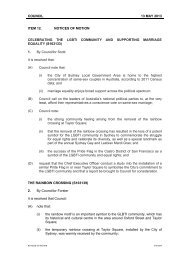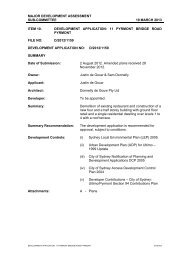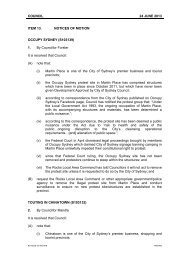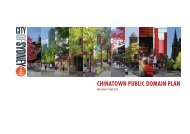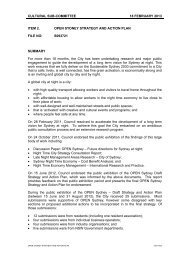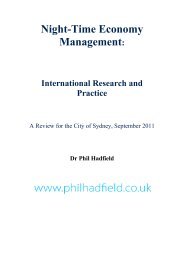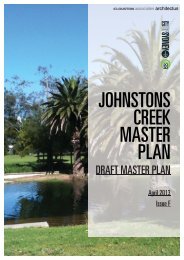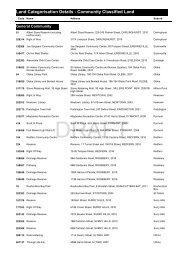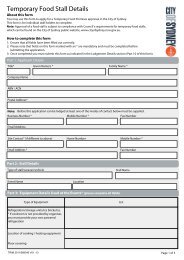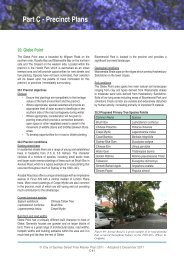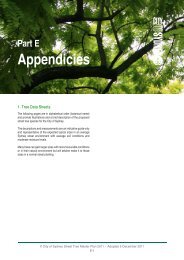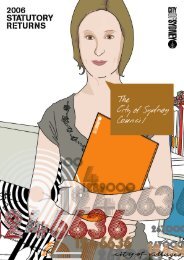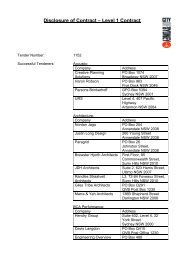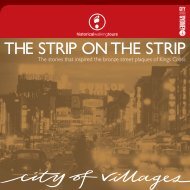Histories of Green Square - City of Sydney
Histories of Green Square - City of Sydney
Histories of Green Square - City of Sydney
You also want an ePaper? Increase the reach of your titles
YUMPU automatically turns print PDFs into web optimized ePapers that Google loves.
<strong>Histories</strong> <strong>of</strong> <strong>Green</strong> <strong>Square</strong><br />
28<br />
common. 27<br />
Other common shrub species included Banksias errata and<br />
Eriostemon australasius while ‘small soaks and concentrations<br />
<strong>of</strong> organic matter in the sand formed locally wet habitats<br />
for Goodenia stelligera, Callistemon citrinus, Button Grass,<br />
Gymnoschoenus sphaerocephalus, and other swamp heath<br />
plants’. 28 On the floodplain <strong>of</strong> Waterloo Swamp, the paperbark<br />
Melaleuca quinquenervia, would also have thrived and can still<br />
be found in Centennial Park.<br />
The Recovery Plan for the ESBS undertaken by the NSW<br />
National Parks and Wildlife Service in Centennial Park (2003)<br />
has found that only ‘twenty-one species <strong>of</strong> native plant…and<br />
sixteen species characteristic <strong>of</strong> ESBS were noted’ in Centennial<br />
Park. This is a rather poor contrast to the dark dense<br />
forest, immense mahogany trees, blackbutt and other eucalyptus<br />
species, as well as cabbage tree palms that once grew<br />
here in great pr<strong>of</strong>usion.<br />
3.4.3 Fauna<br />
Many species <strong>of</strong> native fauna once existed at <strong>Green</strong> <strong>Square</strong>.<br />
Some <strong>of</strong> these can still be found in the Botany Bay National<br />
Park and Hawkesbury Sandstone environments. Unfortunately,<br />
most <strong>of</strong> these species would not be able to survive in the<br />
heavily built up <strong>Green</strong> <strong>Square</strong> <strong>of</strong> today. However, many species<br />
<strong>of</strong> native birds can survive here, and have been recorded in the<br />
area, including seventy species in the suburb <strong>of</strong> La Perouse<br />
Table 3.1<br />
alone. 29 The National Parks and Wildlife Service lists some<br />
<strong>of</strong> the more common species <strong>of</strong> native animals once found<br />
here, in Table 3.1. This list is a very incomplete account <strong>of</strong><br />
<strong>Sydney</strong>’s unique species <strong>of</strong> wildlife. Moreover, it is a reminder<br />
that, although many <strong>of</strong> these animals no longer exist at <strong>Green</strong><br />
<strong>Square</strong> (nor could they), we should do more to preserve the<br />
native species that can, and still do, exist in the area generally.<br />
3.5 <strong>Green</strong> <strong>Square</strong> environment as a cultural landscape<br />
3.5.1 Cultural significance<br />
The pre-European environment is also ‘cultural environment’.<br />
Here I am using the ideas <strong>of</strong> geographers who point out that<br />
‘culture is (re) produced—it is not ‘natural’. Humankind are<br />
not born into static cultural groups that we cannot transcend…<br />
culture [is] socially constructed—a dynamic product <strong>of</strong> individuals<br />
and groups, both past and present’. 30 The way people<br />
saw, experienced and used natural environments was bound<br />
up with their culture and so became part <strong>of</strong> it. Our heritage<br />
is made up <strong>of</strong> many layers <strong>of</strong> historical and cultural meaning,<br />
including environmental ones, and we need to both understand<br />
those meanings and preserve what we can <strong>of</strong> them.<br />
Aboriginal culture was inseparable from country and also<br />
impacted on the land, but they knew and respected the land<br />
in very different ways to Europeans. The vegetation in the<br />
swamps, heath, and scrubland around <strong>Green</strong> <strong>Square</strong> would<br />
Common Name Scientific Name Status<br />
Southern Brown Bandicoot Isoodon obesulus Endangered<br />
Long-nosed Bandicoot Perameles nasuta Rare<br />
Common Brushtail Possum Trichosurus vulpecula Common<br />
Common Ringtail Possum Pseudocheirus peregrinus Common<br />
Eastern Grey Kangaroo Macropus giganteus Common<br />
Parma Wallaby Macropus parma Vulnerable<br />
Red-necked Wallaby Macropus rufogriseus Rare<br />
Swamp Wallaby Wallabia bicolor Rare<br />
Red-necked Pademelon Thylogale thetis Rare<br />
Short-beaked Echidna Tachyglossus aculeatus Common<br />
Diamond Python Morelia spilota spilota Common<br />
Eastern Blue-tongued Lizard Tiliqua scincoides Common<br />
Emu Dromaius novaehollandiae Common<br />
Grey-headed flying foxes Pteropus poliocephalus Common<br />
Eastern brown snake Pseudonaja textiles Common<br />
Red-bellied black snake Pseudechis porphyriacus Common<br />
Eastern long-necked tortoise Chelodina longicollis Common<br />
<strong>Green</strong> and golden bell frog Litoria aurea Threatened<br />
Squirrel Glider Petaurus norfolcensis Vulnerable<br />
Sugar Glider Petaurus breviceps Common<br />
Eastern Quoll Dasyurus viverrinus Endangered<br />
Spotted-tailed Quoll Dasyurus maculates Vulnerable<br />
Tiger Quoll Dasyurus maculates Vulnerable<br />
Brush-tailed Phascogale Phascogale tapoatafa Endangered<br />
Coppertail Skink Ctenotus taeniolatus Common<br />
Pale-flecked Garden Skink Lampropholis guichenoti Common<br />
Brown Antechinus Antechinus stuartii Rare<br />
© Jason Doran<br />
have provided them with the natural resources for daily life<br />
(see Chapter 5). Europeans acquired large land grants here<br />
and from 1823, mills were established, and dams built on<br />
the swamps. Later water collected around the <strong>Green</strong> <strong>Square</strong><br />
area supplied the growing and evermore thirsty town. Poor or<br />
non-existent regulation, coupled with a growing population<br />
that moved into the Botany Basin region over the nineteenth<br />
and twentieth centuries, meant uncontrolled exploitation,<br />
and the land surrounding <strong>Green</strong> <strong>Square</strong> suffered greatly due<br />
to the overuse <strong>of</strong> natural resources and severe pollution (see<br />
Chapters 4 and 6).<br />
Fortunately, the importance <strong>of</strong> the natural qualities and significance<br />
<strong>of</strong> the area were recognised in one sense: Centennial<br />
Park, dedicated as ‘the People’s Park’ in 1888, was preserved<br />
for future generations. Centennial Park is <strong>of</strong> vital cultural<br />
significance to the people <strong>of</strong> the eastern suburbs <strong>of</strong> <strong>Sydney</strong>,<br />
a place <strong>of</strong> recreation and tranquility, as well as a refuge for<br />
native flora and fauna.<br />
3.5.2 Social values<br />
All <strong>of</strong> the interrelated aspects <strong>of</strong> the environmental history <strong>of</strong><br />
<strong>Green</strong> <strong>Square</strong> discussed in this volume are also <strong>of</strong> present-day<br />
social value. 31 This includes the natural landscape, where it<br />
still exists, as well as Aboriginal and European heritage. Many<br />
Aboriginal people place a high social value on natural heritage,<br />
especially the landscapes, plants and animals which provide<br />
sustenance and links with country. The Australian community<br />
in general also places a high social value on parks and reserves.<br />
While social values once revolved around the area as a source<br />
<strong>of</strong> food and water, today <strong>Green</strong> <strong>Square</strong>’s imagined future is<br />
dominated by a built environment <strong>of</strong> futuristic building<br />
designs, with broad plazas and public art. But this new environment<br />
needs to incorporate past natural/cultural heritage<br />
in order to maintain or recover continuity and foster public<br />
memory.<br />
3.6 Ideas for interpretation<br />
Aesthetically pleasing restoration work is currently being<br />
undertaken in Centennial Park, maintaining and restoring<br />
biodiversity; it is also attracting large numbers <strong>of</strong> visitors. The<br />
re introduction <strong>of</strong> native species to the Park by the Centennial<br />
and Moore Park Trust has also had a great effect on improving<br />
the natural qualities <strong>of</strong> the area. Although these are long-term<br />
programs and involve a large area <strong>of</strong> parkland, their successful<br />
methods could perhaps be applied at <strong>Green</strong> <strong>Square</strong>, both the<br />
Town Centre, and in the area generally, as has been achieved at<br />
the Victoria Park development (see Chapter 9). For example,<br />
rows <strong>of</strong> strategically placed ESBS species that grow to varying<br />
heights could be used in the <strong>Green</strong> <strong>Square</strong> Town Centre design.<br />
Vegetation could be planted in busy and open areas to filter<br />
noise and wind in particular, which still blows regularly from<br />
the west and south-west. The cabbage tree palm and the grass<br />
tree were also once common to the area and could be used in<br />
conjunction with other species, such as banksias.<br />
The area’s wetlands were a valuable asset to the inhabitants <strong>of</strong><br />
<strong>Sydney</strong> and a significant part <strong>of</strong> Australia’s history. Displays<br />
<strong>of</strong> native plantings could have aesthetically pleasing signs<br />
explaining their natural history and human usage, as well as<br />
the meaning and significance <strong>of</strong> the ESBS. Engraved stone<br />
monuments (rather than metal signs) would provide a natural<br />
earthy feel. Easy access should also be a priority to allow<br />
visitors room to view the vegetation closely, without disturbing<br />
the ground or other plants growing nearby.<br />
© Jason Doran<br />
Chapter 3 – The Pre-European Environmental Landscape<br />
3.7 Conclusion<br />
The landscape <strong>of</strong> <strong>Green</strong> <strong>Square</strong> was one <strong>of</strong> swamps and<br />
sandhills covered in shrubland. Sandy wind-swept soils had<br />
overlain a natural depression in the Hawkesbury sandstone,<br />
which collected and filtered large amounts <strong>of</strong> fresh water.<br />
Observations made by early European explorers and settlers<br />
portray a wild and rugged place, which once extended right<br />
across the Botany Basin, a place teeming with wildlife, a<br />
unique and diverse array <strong>of</strong> native flora and fauna, adapted to<br />
a distinct set <strong>of</strong> environmental factors. Water, wetland plant<br />
species, birds and animals in turn supplied Aboriginal people<br />
and European settlers with vital resources.<br />
This environmental landscape has been radically altered since<br />
European settlement. The systematic draining and polluting<br />
<strong>of</strong> Lachlan and Waterloo Swamps and local streams have<br />
robbed <strong>Green</strong> <strong>Square</strong> <strong>of</strong> many <strong>of</strong> its natural features. Environmental<br />
degradation has been caused by industrial exploitation<br />
and the diversion <strong>of</strong> water to supply the expanding township<br />
<strong>of</strong> <strong>Sydney</strong>. Changes were also due to periods <strong>of</strong> drought, the<br />
introduction <strong>of</strong> domestic animals and the clearing <strong>of</strong> vegetation.<br />
Despite these changes, we have the ability and knowledge<br />
to restore some <strong>of</strong> what has been lost to us. By doing so, we<br />
will be helping to preserve and maintain Australia’s natural<br />
and cultural past and our place in it.<br />
29



